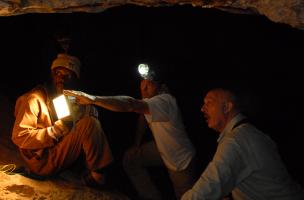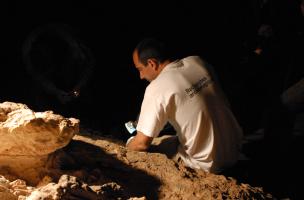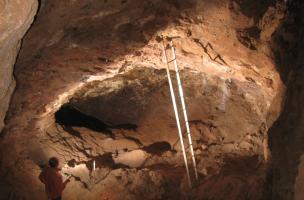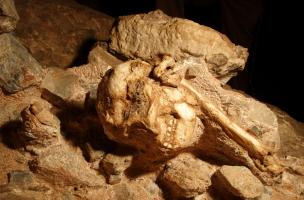You are here
Little Foot, a South African Australopithecus as old as Lucy?
Sterkfontein, located to the north-west of Johannesburg in the province of Gauteng, is part of a zone classified by UNESCO in 1999 as a World Heritage Site called the “Cradle of Humankind”.
Since its discovery in 1997 in Silberberg Grotto, a skeleton known as Little Foot has been meticulously excavated. Found under exceptional circumstances, this Australopithecine, which is the most complete ever identified, contributes unique elements to our knowledge of human origins. Although its age, somewhere between 2 and 4 million years, is still debated, a team of French researchers, in collaboration with the University of the Witwatersrand (Johannesburg), has contributed new elements to its dating.
An exceptional discovery

Little Foot’s faux pas
The history of Little Foot is very different. Perhaps while being pursued by a predator, this individual fell more than twenty meters into a hole and died. The body then rolled down a scree slope where it landed with one arm stretched over the head and the other at its side. Through time, the body was buried under more than ten meters of sediments and rocks.
Last research before extracting the fossil
In 2007, at the request of the South African university, Laurent Bruxelles, an Inrap geomorphologist, undertook this difficult problem of chronology and untangled the sequence of strata containing the skeleton. Working with Ron Clarke, this karst system specialist has now demonstrated that the strata dated to 1.5 to 2.2 million years ago are not contemporary with Little Foot. Based on a study of the sediments containing the hominid, he again attributes it to an earlier age, closer to 3 million years or more. It turns out that the previous dates were realized on flowstones that were deposited long after the death of the Australopithecus. From the time of its fossilization to the deposition of these flowstones, several geological stages were distinguished, each implying slow processes that would have occurred over a long time period.
Little Foot would thus be nearly contemporary with a much less complete fossil skeleton, Lucy, the famous Australopithecus afarensis discovered in 1974 in Ethiopia, about 3 million years in age.
Before the fossil was extracted, in January 2010, a French team created a three-dimensional model of it in the cave. Laurent Bruxelles and José Braga (paleoanthropologist, Paul Sabatier University, Toulouse), along with a group of computer and 3D scanning specialists, Gérard Subsol (LIRMM), Jean-Pierre Jessel (IRIT) and Benjamin Moreno (IMA Solutions), produced several scans at different resolutions. Their aim was to preserve not only all of information pertaining to the skeleton, its position and morphology, but also all of the sedimentary data related to its context. They are currently reconstructing the entire fossil in three dimensions.
The role of Little Foot in the history of human origins
Little Foot was not yet human since he lived more than a million years before the appearance of the first humans in Africa. He is an Australopithecus, a group of pre-humans that are very well represented in southern Africa.
Various anatomical arguments indicate that at least two Australopithecine species lived in southern Africa around 3 million years ago, notably at the site of Sterkfontein. Though the presence of Australopithecus africanus is well known, based on his continuing research, Ron Clarke attributed Little Foot to the second, less famous species, Australopithecus prometheus. With Little Foot, researchers can now study a nearly complete skeleton of this second species! The scientific implications are highly significant since one of these two lineages might have been a close ancestor of the first humans, while the second probably left no descendants.
Several neighboring caverns or open-air sites are currently being studied by South African and international teams. Since 1995, paleoanthropologists José Braga and Francis Thackeray from the University of the Witwatersrand in Johannesburg have directed excavations at the site of Kromdraaï with the aim of learning more about the appearance of the genus Homo.
While participating on this excavation, Laurent Bruxelles is also conducting a geomorphological study of the entire sector. His goal is to understand the evolution of the landscape and the succession of events that resulted in the formation of the caves, the presence of fossil deposits within them and their later evolution. Building on this foundation, a study of the paleo-climates at the time when these sites were frequented by hominids has recently begun.
In parallel with this work, in 2012, a survey made by a drone equipped with a high resolution infrared camera enabled the discovery of several cave entrances that remain to be studied. At Sterkfontein, the team consisted of Florent Hautefeuille, Nicolas Poirrier and Carine Calastrenc (UMR 5608 TRACES and Terrae Platform) was even able to locate the shaft through which Little Foot may have fallen into the cave.
This research is funded by the French Embassy in South Africa, the Ministry of Foreign Affairs, the city of Toulouse, the University of the Witwatersrand (Johannesburg), the Palaeontological Scientific Trust (www.past.org.za) which has supported research at Sterkfontein Caves for nearly two decades, the National Research Foundation, Inrap and the CNRS.


Mahaut Tyrrell
Media communication
Inrap, media partnerships and relations
01 40 08 80 24
mahaut.tyrrell [at] inrap.fr






